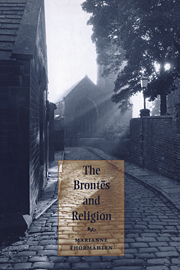Book contents
- Frontmatter
- Contents
- Acknowledgements
- Abbreviations and editions
- Introduction
- I Denominations
- Chapter 1 A Christian home in early nineteenth-century England: Evangelicalism, Dissent and the Brontë family
- Chapter 2 Charlotte Brontë and the Church of Rome
- Chapter 3 An undenominational temper
- II Doctrines
- III Ethics
- IV Clerics
- Notes
- Select bibliography
- Index
Chapter 1 - A Christian home in early nineteenth-century England: Evangelicalism, Dissent and the Brontë family
Published online by Cambridge University Press: 22 September 2009
- Frontmatter
- Contents
- Acknowledgements
- Abbreviations and editions
- Introduction
- I Denominations
- Chapter 1 A Christian home in early nineteenth-century England: Evangelicalism, Dissent and the Brontë family
- Chapter 2 Charlotte Brontë and the Church of Rome
- Chapter 3 An undenominational temper
- II Doctrines
- III Ethics
- IV Clerics
- Notes
- Select bibliography
- Index
Summary
The spiritual elements that were present in Haworth Parsonage can be viewed as microcosmic representations of religious currents in Britain from 1800 to 1850. These movements transformed the life of the Established Church; created a major new Nonconformist community as Methodism formally separated from the Church of England; and resensitised the historically painful area along the boundary between the Anglican Church and Roman Catholicism. The family at the Parsonage felt the impact of all these events, and each of the Brontë sisters attempted to steer her own course among them with characteristic fearlessness and determination.
This absence of stasis in the religious lives of the sisters is another reason to avoid simple categorisation where their beliefs are concerned, in addition to the seeming contradictions and paradoxes referred to above. The terms in which Hoxie Neal Fairchild describes the Brontës' religion are over-simplified by any standards:
Anne, never much tempted to smash through the wall which surrounded her, was a mildly faithful Evangelical. Charlotte, in whose mind Jane Austen and Mrs. Radcliffe contended for mastery, was a Broad Churchwoman. Emily, so pure a romantic that she reminded Matthew Arnold of Byron, cared nothing about Christianity, broad or narrow.
Two of the most important religious influences on Patrick Brontë were Wesleyan Methodism and Evangelicalism in the Church of England, as he came to know and absorb it at Cambridge.
- Type
- Chapter
- Information
- The Brontës and Religion , pp. 13 - 23Publisher: Cambridge University PressPrint publication year: 1999



